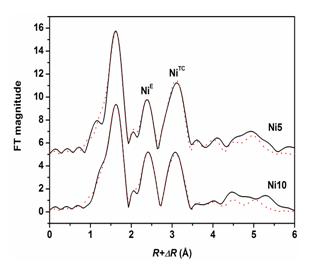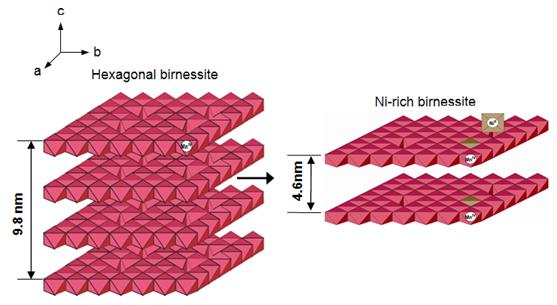| Effects of Ni doping on the structure and properties of birnessite and implication for Ni enrichment |
| From: PublishDate:2013-06-15 Hits: |
Ferromanganese minerals occurred in soils, sediments and sea floor are generally enriched in various transition metals (TMs). Hexagonal birnessite is the most ubiquitous and reactive manganese oxide in geological environments. Incorporation of TM ions into birnessites not only affects their valence and speciation, but also results in certain changes in (sub)structure and physicochemical properties, consequently affecting the geochemical behaviors of heavy metals and organic pollutants. A soil minerals team led by professor Fan Liu from college of resources and environment, Huazhong Agricultural University has gained insight into the interaction mechanism of Ni with hexagonal birnessite. Their research has been published on September 15th, 2012 in Geochimica et Cosmochimica Acta. In order to mimic natural conditions, Ni-doped birnessites were synthesized by Ni coprecipitation with Mn. Modern analytical techniques (XRD, FESEM, XPS, XANES and EXAFS) were carried out to investigate the effects of Ni doping on the substructure and physicochemical properties of birnessite and Ni crystal chemistry in birnessite, and isothermal adsorption and oxidation of metal(loids) (Pb2+, Zn2+, As(III)) were also conducted. The following results are obtained: (1) These Ni-rich birnessites have Ni contents as high as 2.99% (Ni5) and 6.08% (Ni10) in weight. EXAFS results show that Ni5 has 23.7% of the total Ni (0.71wt.%) and Ni10 has 34.5% of the total Ni (2.10 wt.%) in Mn octahedral layer with the remaining Ni located at vacancies and edge sites (Figure 1). Combination with the fact that Ni in natural ferromanganese crusts and nodules are located in Mn layers, it is suggested that i) Ni coprecipitation with Mn and ii) Ni migration into layers after adsorption on the surface of birnessite are two important mechanisms for enrichment of Ni in birnessite, and the latter is probably the main mechanism. (2) The Ni-rich birnessites have weaker crystallinity and thermal stability, fewer layers stacked along the c axis (Figure 2), ~1.5-2.7 times larger surface areas, and a higher Mn average oxidation state and more vacancies compared to the birnessite without Ni. (3) adsorption capacities for Pb2+ and Zn2+ by these Ni-rich birnessites are reduced for that large amounts of Ni2+ are occupied above/below vacancies. (4) The Ni-rich birnessites exhibit much higher oxidation capability and can completely oxidize As(III) in solution at rapid initial reaction rates under the experimental conditions. These results provide novel insights into the interaction mechanisms of TMs with birnessite and geochemical controls of environmental contaminants by birnessites. It can also help us explore oceanic polymetallic manganese nodules resources.
Figure 1 Ni K-edge Fourier transformed (FT) EXAFS spectra (solid line) of Ni5 and Ni10 with best fit overlaid (dotted line).
Figure 2 Illustration of variation in crystal sizes of Ni-rich birnessites in the c direction
Article: Hui Yin, Wenfeng Tan, Lirong Zheng, Haojie Cui, Guohong Qiu, Fan Liu*, Xionghan Feng*. Characterization of Ni-rich hexagonal birnessite and its geochemical effects on aqueous Pb2+/Zn2+ and As(III). Geochimica et Cosmochimica Acta 93, 47-62, 2012. |
|
|
| Chinese
Science Highlights
Home /
Copyright © 2011 - 2012 Beijing Synchrotron Radiation Facility



